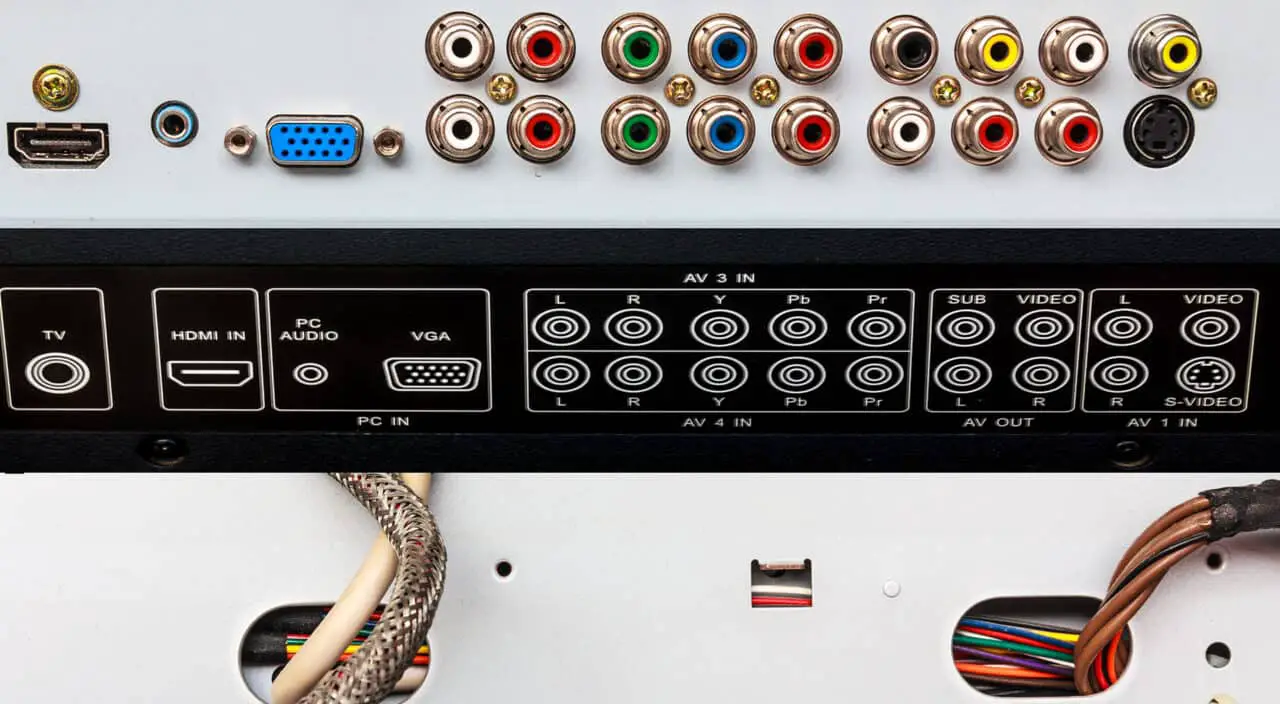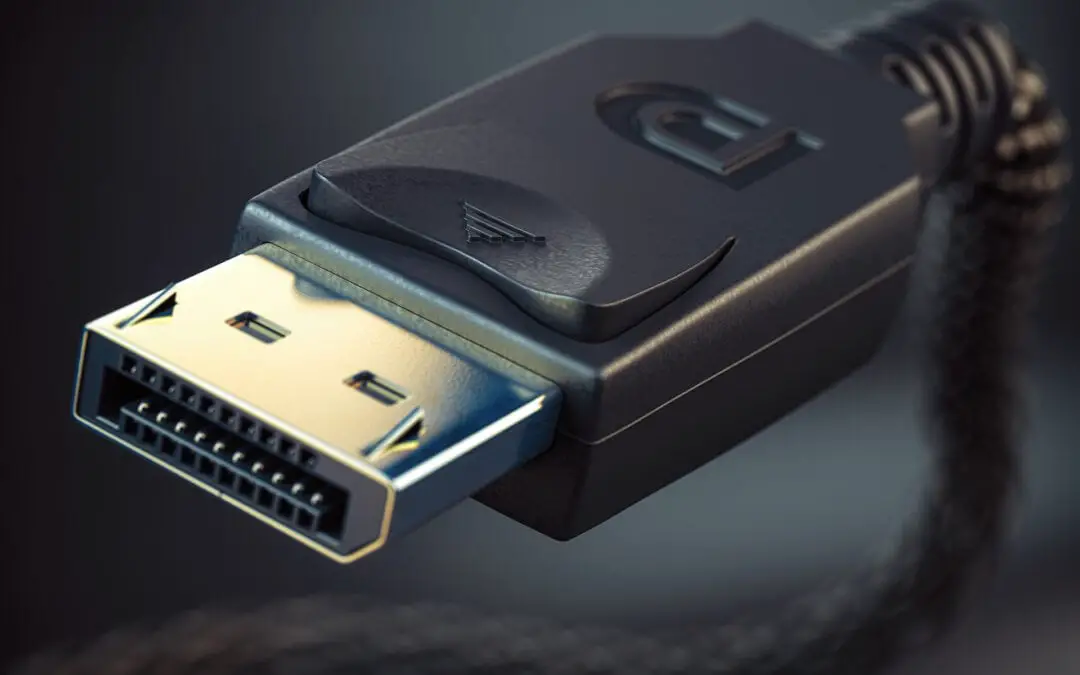You may have noticed that the back of your TV set doesn’t have a DisplayPort. You will typically have multiple HDMI ports and a USB port but no DisplayPort. Why don’t more TVs have DisplayPort?
HDMI was made for the TV industry by the TV industry. This technology predates DisplayPort 1.4, and TV companies can collect royalties from HDMI. There’s also the fact that most home entertainment devices support HDMI, and DisplayPort could not carry audio until the release of version 1.4.
Despite this obstacle, you can convert DisplayPort to HDMI with a cable and adapter. In the sections below, the impact of this on audio/visual performance will be discussed. Also, you’ll be introduced to the best TVs with DisplayPort built-in.
Table of Contents
Most Devices Use HDMI Connections
HDMI can serve almost every electronic device you have in your entertainment space. Laptops, gaming consoles, TVs, sound bars, and much more. You name it, and it probably has an HDMI port.
Most importantly, HDMI offers consumer electronics control (CEC). This allows you to control up to 15 different devices with just a single remote. This is far superior to the DisplayPort alternative.
The more recent updates to DisplayPort Work with CEC commands, but you would need an HDMI port and the appropriate adapter for functionality.
What You Can Do If No Available TVs Have DisplayPort

You Can Always Find Adaptor Cables
Speaking of adaptor cables, these are never in short supply. This offers a simple workaround if you are sourcing from a device that does not have an HDMI port.
Some DisplayPort Versions Do Not Support Audio Transport
DisplayPort cables did not display audio until the release of DisplayPort 1.4 in 2016. This is another good reason why most of this era’s TV monitors do not have the DisplayPort option.
With the enhanced features of DisplayPort 2.0, you may begin to see more of these ports on TV monitors.
Adapter Cables Are Easy To Find: How To Connect HDMI To DisplayPort
One of the reasons that TVs don’t have DisplayPort is that you can find adapters for every possible connection type. Whether you’re talking about HDMI to DisplayPort or Mini DisplayPort to HDMI doesn’t matter.
Here are the many adapter cables you can purchase:
- DisplayPort to HDMI Adapter
- Mini DisplayPort Thunderbolt to HDMI
- 4K DisplayPort to HDMI Adapter Cable
- USB-C to DisplayPort Adapter
You are encouraged to refer to the FAQs section at the bottom of this article. This will provide further clarity on picking the right adapter cable (such as knowing when to use an active cable rather than a passive one.)
You Can Buy Premium HDMI Cables For Greater Performance
You can supplement your performance needs by purchasing a premium HDMI cable. This premium HDMI cable offers 4K video support to the tune of 4K at 60 Hz. You can also purchase an 8K HDMI cable.
So, you are not losing out by not having DisplayPort on your TV. Before purchasing a TV with DisplayPort, you should try to see what a premium HDMI cable can do for you.
TV Companies Created HDMI & Receive Royalties
There’s also the reality that consumer electronics manufacturers created HDMI. These companies can charge royalties for HDMI. Meanwhile, DisplayPort was made by the PC hardware industry. It’s also royalty-free.
HDMI 2.1 Has Display Stream Compression
DisplayPort 1.4 was the first cable to support Display Stream Compression. What exactly does this mean? DisplayPort can reduce bandwidth demand in devices with ultra-high definition displays, such as gaming consoles and Blu-ray players.
With the introduction of HDMI 2.1 in 2017, HDMI can now support 8K resolution, albeit at lower speeds. With this significant improvement, is HDMI 2.1 better than DisplayPort 1.4? And what about DisplayPort 2.1, which is on the horizon?
Is HDMI 2.1 Better Than DisplayPort?
It depends on what you mean by “better.” In terms of refresh rate, DisplayPort holds a clear advantage. HDMI 2.1 maxes out at 6 GB/s, while DP 2 can deliver 9 GB/s.
Refresh Rate
This doesn’t make much difference with 4K resolution since roughly 2.23 GB/s is the minimal requirement. But once you start talking about a screen resolution of 8K, HDMI 2.1 can only support this display at 50 Hz. DisplayPort is substantially higher, capable of supporting 8K at 120 Hz.
However, this speed advantage is considered negligible for the average consumer. Most people simply won’t notice it with the technology they have on hand.
Multi-Stream Transport: HDMI Doesn’t Have It
Multi-stream transport (or MST) allows you to connect multiple displays to a single display from a source computer. This can undoubtedly be a helpful tool with computer monitors. You can do this with DisplayPort but not with HDMI.
What you can do, however, is use a DisplayPort to HDMI hub to achieve a similar result. You will always need a source with a DisplayPort, and then you can connect to HDMI using a splitter like the one found here.
For Gamers
Ultimately you won’t be able to take advantage of the premium features of either DisplayPort or HDMI if you don’t have matching hardware. For instance, you may have a PC with a port for an HDMI 2.0 video card, and you are connecting to a TV with a 2.1 HDMI port.
You will not be able to unlock the full perks of 2.1 on your PC. So the performance argument can become a moot point anyways.
Interlocking Cable
The DisplayPort cable is much harder to rip out of its port accidentally. This is thanks to the locking connection at the end of the cable. This can be either a good thing or a bad thing. If someone trips over a DisplayPort cable, there is an increased chance that the entire TV will come down.
By the way, it is worth mentioning that there are many different ways to conceal exposed cables. Wall cord covers like this are popular. This reduces the tripping hazard, makes your living room look nicer, and can help keep your cables from wear and tear.
Stay Tuned For The Arrival Of DisplayPort 2.1
Of course, technology continues to evolve. In 2023, DisplayPort 2.1 is expected to be released. While this will certainly have implications for PC gaming, the impact on the TV industry is much less clear.
For now, you are encouraged to keep visiting this site for updates. The next wave of DisplayPort may revolutionize the industry.
Best Monitors With DisplayPort
While there are certainly TVs with DisplayPort, gaming monitors, in particular, will have them more often. In the sections below, you’ll find a solid list of monitors with DisplayPort to get you started in your research.
Spectre 30-inch Curved Gaming Monitor
This Spectre 30-inch curved monitor is loaded with options for cables. It has 2 HDMI 1.4 ports, an HDMI 2.0 port, and a DisplayPort. It also has AMD Free Sync, designed to overcome the differences between a graphic card’s frame rate and the monitor’s refresh rate.
Another plus is that it is reasonably priced, a feature not always common among monitors with the DisplayPort option.
Viewsonic Viewboard
This Viewsonic Viewboard has multiple HDMI ports, DisplayPort, and a 60W-powered USB-C port. This type of monitor will give you the enhanced features you need for both work and play.
Price-wise, it is certainly at the higher end, but it does have a touch screen.
Aorus FV43U
The Aorus FV43U has a 1.4 DisplayPort, 2 HDMI 2.1 ports, 2 USB 3.0, and 1 USB-C. This monitor gives you the greatest versatility in terms of connections. Additionally, it has a 144 Hz refresh rate and High Bit Rate 3 Support.
For those unfamiliar, High Bit Rate 3 is the standard DisplayPort 1.3 video cards use. At 8K, this means monitor resolution of up to 60 frames per second. At 4K, you get a resolution of up to 120 frames per second.
Are TVs With DisplayPort Worth It?
As you’ve seen in the list above, TVs with DisplayPort can be few and far between. This is not to say that you can’t find any, but you expect to pay at least twice as much as you would with most TVs.
The most significant advantage of DisplayPort is the faster refresh rate. Gamers prefer DisplayPort over HDMI because of this. If you wish to connect a gaming PC to a monitor, you certainly cannot go wrong with DisplayPort. It can even be a necessity.
For most consumers who are not PC gamers, springing for a TV with DisplayPort is hardly worth it. Most modern TVs are designed to prevent lagging with gaming consoles anyways.
FAQs
These are some customers’ most common questions about DisplayPort and TVs.
Can I Convert HDMI To DisplayPort?
If you are connecting a DisplayPort device to the HDMI port on your TV, you only need an adapter cable. There are 2 types of adapter cables: passive and active.
- Passive adapter cables can be used if the source (such as a PC) supports dual-mode DisplayPort (abbreviated DP++).
- Active adapters can make the conversion regardless of whether or not the source supports dual-mode DisplayPort.
Active adapters are more expensive than passive adapters. If you need to know which type of DO your device supports, then it is best to check with the manufacturer before purchasing.
Do You Lose Quality When You Convert HDMI To DisplayPort?
Image quality comes down to your TV type and its max resolution. Converting DisplayPort to HDMI in and of itself will not result in a loss of video or audio quality. The length of the cable is important, as Dell recommends using a cable that is roughly 6 feet or less in length.
If you are experiencing issues, you may need to double-check your cables. As mentioned above, there are several types of cables, including premium HDMI cables and passive/active adapter cables. Scroll up to the guidance above on choosing the right cable.
Otherwise, it may just be time to upgrade to a better TV. With each passing model year, 8K TVs are becoming more affordable for the average consumer. Take, for example, the price tag on this Hisense A6 Series 43-inch TV.
Recent model-year TVs also come with features like Chromecast already built-in, moving you away from the need to have cables strewn throughout your living room.
Does DisplayPort Support Audio?
With the release of Version 1.4, DisplayPort can support audio and video transfer. As mentioned before, the performance of HDMI 2.0 and DP 1.4 is similar, with the caveat that DP is designed for computing, and HDMI is catered towards the TV industry.
Can You Cast A Gaming Laptop To A TV?
Casting through Chromecast/AirPlay and other dongles are designed for casting apps and web pages to a TV monitor. Each version of these carries some limitations. For gaming, your most reliable video & audio transfer source will be a physical cable and the appropriate adapter (as needed).
But for streaming purposes, screen mirroring is a great tool to have. Most streaming apps also allow you to cast from your phone or laptop within the app itself. So depending on the age of your equipment, you may not even need to purchase a wireless dongle to plug into your TV.
Final Thoughts
Most TVs do not have DisplayPort because the TV industry created HDMI. DisplayPort was designed for computing. You can use adapter cables to convert DP to HDMI. Just be sure to purchase the correct type of cable.
You may also be interested in: Can HDMI ARC Be Converted to RCA?
Gaming monitors also allow you to directly plug a DP cable into the TV, as with an HDMI. This could be a wise purchase if you are a serious PC gamer. Otherwise, standard and premium HDMI cables should be sufficient.
